
Wine Culture and Information since 2002 - Volume 22
 Wine Culture and Information since 2002 - Volume 22 |
|
Issue 78, October 2009 |
Contents |
|
|
Harvesting in Time of Crisis |
|
Grape harvesting in Italy is now almost done, in many regions of our country the must is now fermenting in the promise of becoming wine. Like every year, also for 2009 there have been predictions about the quality of the forthcoming wines and many told in this year we will have a five stars harvesting. A good news, although - to tell the truth - we are used to news like that: every year it seems we are going to have the “harvesting of the century”, despite it has begun few years ago. Despite the anticipations revealed by these predictions - while wishing they will become true - quality of 2009 vintage will be concretely evaluated in few months, when wines will finally be poured in glasses. A method which certainly is pitiless, but it certainly is reliable and determinant, leaving no room to further considerations or conjectures. And this is true for every harvesting and for every vintage. Predictions apart, vintage 2009 will also be remembered, besides for its desirable quality, also for the particular time of economic conditions - which certainly are not brilliant - and the world of wine is no exception. Vintage 2009 undoubtedly is a year feeling the effects of the crisis, which will bring with it the difficulties of 2008 which will be added to the unavoidable hard conditions of 2009. Wine is not having a good time, both in sales as well as in production. Italian wine feels the effects of crisis and the situation certainly is not one of the most favorable ones. There are in fact many producers who have just finished harvesting, in other words, they are bringing more grapes in the cellar and are about to make wine, while having the cellar literally full of unsold bottles of vintage 2008. Does this seem to be a problem to be taken lightly? The idea of accumulating other bottles in cellar, with the risk of not selling them all, certainly is an hypothesis alarming every producer. Most of the wine belonging to vintage 2008 and destined to “immediate consumption” - therefore most of whites, roses and the so called young reds - is in fact in producers' cellars, unsold and therefore cause of economic loss. The hope of selling them in the next months, that is when the market will ask for young 2009 wines only, is pretty remote. What will become of this wine? It is very likely it will sold to distilleries at very low prices, exclusively interested to the ethyl alcohol they can get from it. After all, this is their job. Crisis characterizing vintage 2009 is not about cellar only, it is also something concerning vineyards, those places in which everything begins and where are set the essential criteria for making a quality wine. A great wine originates from great quality grapes: mediocre grapes give a mediocre wine, even though - in this sense - it may sometimes happen they can make a sort of “miracle” in cellar. 2009 sees in fact a generalized drop in grape prices, therefore diminishing profits of farms who cultivate grapes and sell them to wineries. According to the Italian associations representing farms, in 2009 there has been a drop of 10% in prices, with evident profit loss for producers. This means, lacking of proper profits, farms which are involved in the cultivation of grapes will be in trouble, and they may also decide to quit their activity or to convert their production to other and more profitable cultures. Despite all that, predictions for 2009 harvesting say production - in terms of quantity - will be almost the same as 2008, even predicting an increase of 5% more than the last year. An amazing paradox, considering the conspicuous quantity of bottles of 2008 wine which are still in cellar and which will be soon full of the new 2009 wine. There are in fact many suggesting and encouraging a fall in production, in particular yields in vineyards, a trend which will undoubtedly favor wine quality. After all, does it make any sense to produce a lot of wine when the market is facing a generalized drop in consumption, a drop which is also determined by the crisis of these times? Moreover, are we sure the drop in wine consumption in Italy is exclusively determined by this economic crisis? It certainly has played a substantial role in this, and it is very likely it is not the only one to be responsible. For example, are we sure the campaign done - at the limit of prohibitionism - against the abuse of alcohol for the prevention of the consequences of driving when one is drunk did not have any responsibility? Let's make things clear once again, driving any vehicle after having exaggerated with alcoholic beverages (therefore not only wine!) is something we do condemn and we believe to be deprecable as well as idiot and stupid. The abuse of alcoholic beverages is however and in any case stupid: the best appreciation is always obtained with moderation. The logic of terror of punishment has however obtained results, including the drop of sales for wine. In case they would have focused more on culture of wise, moderate and intelligent drinking - instead of forbidding - today things would may have gone differently. Let's be happy of the fact 2009 vintage will be of good quality, at least, by considering the not so good times caused by this crisis, we will have something to be happy for. Like every year, we just need to wait for time to do its patient job on wine, waiting for springtime, season in which we will begin to see and taste the results of the efforts in vineyard and in cellar. And who knows if the drop of grape prices will also bring a drop in prices of 2009 wines? We doubt this to happen, and we will however have to wait for springtime to know. After all, it is in times of crisis the old saying mors tua, vita mea (your death, my life) seems to be true. We will see. For the moment, welcome 2009 harvesting while wishing it will be the beginning - despite the troubles of these times - of a new renaissance for wine and viticulture economy.
|
||||
Comparing Salice Salentino RossoSalice Salentino Rosso is one of the main wine glories of Salento, a red wine made with the famous Negroamaro grape and Malvasia Nera di Lecce |
|
In the interesting wine scene of Apulia, a region mainly known for wines made from Primitivo grape, there is a prestigious and excellent grape capable of giving quality wines: Negroamaro. Apulia, which for years has been the main provider of grapes and wines for blending, that is used for reinforcing the wines of other Italian regions which - for environmental, viticultural and meteorological reasons - were characterized by not really strong bodies. The first wines to give notoriety to Apulia have certainly been the ones produced with Primitivo grape, in particular the ones from Manduria, however in this region, where the sun shines more than in any other place, vineyards are also rich of other interesting grapes, such as Negroamaro and Malvasia Nera, protagonists of the wines of this month's comparative tasting: Salice Salentino Rosso. The wine gets its name from the homonymous city in the province of Lecce, an area having the status of Denominazione d'Origine Controllata (DOC, Denomination of Controlled Origin), where are also produced white, rose, fortified and sparkling wines. The main protagonist of Salice Salentino undoubtedly is Negroamaro, which in this wine must be for at least 80%, whereas Malvasia Nera di Lecce completes the composition of the wine for the remaining part. Negroamaro, which origins are uncertain - although it is believed it was introduced by Greeks - is one of the main red berried grapes of Apulia, capable of making truly quality wines. Also the origin of the name is not clear, it is in fact believed it is originated by the local dialect, as well as being originated from Latin and ancient Greek languages. Some believe Negroamaro comes from the dialectal expression “niuru maru”, that is black and bitter, because of the dark color of its berries and the basically bitter taste of its wines. Others believe it originates from the Latin word niger and ancient Greek word mavro, in both languages meaning black, therefore emphasizing the dark and black color of the berries. Also Malvasia Nera is characterized by dark berries, and its origin is probably from Greece. The name derives - just like any other Malvasia grape - from a Greek city in Peloponnese, known as Monemvasia, meaning “single entrance”. It were Venetian merchants to call these grapes - for assonance - Malvasia.
|
|
The territory of Salice Salentino DOC provides for the production of many wine styles, of them, the most famous and appreciated ones are rose and red. Both styles are produced with Negroamaro and Malvasia Nera di Lecce grapes, the former being present for at least 80%, the latter for the remaining part. The wines from this area are produced in the entire territory of Salice Salentino, Veglie and Guagnano municipalities - in province of Lecce - and in those of Pancrazio Salentino and San Donaci, in province of Brindisi. Salice Salentino is also produced in part of the territories of Campi Salentina - in province of Lecce - and Cellino San Marco, in Brindisi. Salice Salentino Rosso can also be produced in the styles “novello” - that is noveaux with the usual carbonic maceration technique - and “riserva” (reserve). Only wines with a minimum alcohol by volume of 12.50% and commercialized after a minimum period of aging of two years, of which at least six months in cask, can be defined as riserva.
The wines of our comparative tasting are all aged in cask or in barrique and two of them are produced as riserva style. The first wine of our comparative tasting is Resta's Salice Salentino Rosso, produced with 80% of Negroamaro and 20% of Malvasia Nera, aged in cask for 10 months. The second wine of our comparative tasting is Cantina Due Palme's Salice Salentino Rosso Riserva Selvarossa, in which Negroamaro is present for 90%, aged for 12 months in barrique. The third wine is Leone de Castris' Salice Salentino Rosso Riserva Donna Lisa, also in this case from Negroamaro and Malvasia Nera grapes, in which has been used a longer aging, about 20 months in barrique. All the wines are selected according to the vintages currently commercialized and will be evaluated at the temperature of 18°C (65°F) in ISO tasting glasses.
|
||||||||
|
The color of Salice Salentino Rosso is mainly determined by Negroamaro, a grape capable of giving wines with intense and deep colors, thanks to the good presence of coloring substances in the skin. Despite it is found in lesser quantity, also Malvasia Nera di Lecce has a good content of coloring substances, capable of giving wines with an intense ruby red color. Transparency in Salice Salentino is generally low, characteristic which is also determined by viticultural and wine making conditions: lower yields in vineyard give grapes with higher concentration of coloring substances. Because of the aging period provided for production disciplinary - at least two years - in Salice Salentino are not observed the typical color of “young” wines and characterized by a purple red hue: at the moment of commercialization it is the ruby red to be observed in the glass. With time, color of Salice Salentino tends to get a garnet red hue, and then brick red, following the usual development of red wines. Let's begin the evaluation of the wines of our comparative tasting from Resta's Salice Salentino Rosso. By tilting the glass over a white surface - such as a simple sheet of paper - we will observe the color of the wine at the base of the glass. We will observe an intense ruby red color and a low transparency. By observing the wine at the edge of the glass, we will evaluate nuances, in this case showing the same ruby red color. Let's now pass to the second wine of the comparative tasting: Cantina Due Palme's Salice Salentino Rosso Riserva Selvarossa. By observing the base of the glass - tilted over a white surface - we will appreciate a low transparency and an intense and brilliant ruby red color, the same color can be observed in the nuance. The third wine of the tasting - Leone de Castris' Salice Salentino Rosso Riserva Donna Lisa - is characterized by a low transparency and an intense and brilliant ruby red, whereas nuances - because of the long aging in barrique - show a garnet red color.
|
|
The olfactory profile of Salice Salentino is characterized by the strength of Negroamaro to which is added the subtleness of Malvasia Nera. It will however be the aromas of fruits and flowers to dominate the olfactory profile of this wine, in particular the aromas of black cherry and plum, to which are added the ones of blueberry and blackberry, including violet, the most typical flowery sensation of Salice Salentino. This interesting wine from Salento, in particular the riserva style, ages in wood containers, therefore it will also be perceived tertiary and spicy aromas typical in this production technique. In Salice Salentino can be in fact perceived aromas of vanilla, tobacco, chocolate and licorice, qualities which are accentuated with the aging in bottle. To these aromas are also added cinnamon, clover, mace and cocoa powder. Despite they are not frequent, in wines produced in this area can sometimes be perceived a balsamic aroma of menthol. The first wine of which we will evaluate aromas is Resta's Salice Salentino Rosso. By holding the glass in vertical position and without swirling, let's proceed with the first smell in order to appreciate the so called opening aromas, that is the qualities mainly identifying a wine and its grapes. From the glass will be perceived intense and clean aromas of black cherry and plum, as well as a pleasing hint of blackberry. After having swirled the glass - therefore favoring the development and oxygenation of all the other aromas, the ones requiring a higher quantity of oxygen in order to volatilize - let's proceed with a second smell. The aroma of blackberry is now strong and intense, moreover, it will be perceived aromas of blueberry, violet, dog rose and raspberry. It will also be perceived complex aromas of vanilla, cocoa powder and tobacco, result of the aging for 10 months in cask. Let's now proceed with the evaluation of the second wine of our comparative tasting: Cantine Due Palme's Salice Salentino Rosso Riserva Selvarossa. The opening of this wine is characterized by aromas of black cherry, plum and blackberry, qualities identifying both Salice Salentino and Negroamaro. After having swirled the glass, let's proceed with the second smell in order to complete the olfactory profile of the wine. From the glass will be appreciated aromas of violet and blueberry, as well as complex aromas of vanilla, tobacco, licorice, clover, cinnamon and a pleasing hint of star anise. The evaluation of the third wine - Leone de Castris' Salice Salentino Rosso Riserva Donna Lisa - gives an opening made from aromas of black cherry, plum and blackberry, not so different from the previous wine. After having swirled the glass, let's proceed with the second smell, therefore completing the olfactory profile of the wine with violet, blueberry, raspberry, vanilla, tobacco, licorice, cocoa and mace. In this wine - aged in barrique for about 20 months - should be noticed the overall aromas recalling fruit jams.
|
||||
|
The taste of Salice Salentino Rosso - as well as its aromas - it is mainly characterized by the quality of Negroamaro, a grape with a strong and robust character, softened by Malvasia Nera. Negroamaro is a grape capable of making wines with a good body and with the characteristic basically bitter taste, qualities which are, like already said, smoothed and mitigated by the more delicate Malvasia Nera di Lecce. The vigorous character of Negroamaro is also mitigated and rounded by aging - which in riserva must be of at least two years, of which 6 months in cask - therefore giving round tannins and velvety qualities. Apulia is among the Italian regions in which sunny days are more frequent than in other places, a condition helping the aging of grapes while developing good quantity of sugar, with the result of making pretty alcoholic wines. In fact, it is not rare to find Salice Salentino Rosso wines with an alcohol by volume higher than 13.5%, alcohol which is however useful in balancing tannins. Let's begin the evaluation of the first wine of comparative tasting: Resta's Salice Salentino Rosso. In the attack of this wine will be appreciated Negroamaro's tannins, not excessively aggressive thanks to the aging in cask, promptly balanced by alcohol which is perceived with its classic burning sensation. Let's now pass to the evaluation of the second wine - Cantine Due Palme's Salice Salentino Rosso Riserva Selvarossa - giving the mouth a more robust attack than the previous wine, with vigorous tannins, although already round and velvety, also balanced by alcohol which in this case is 14%. Let's now proceed with the third wine of our comparative tasting: Leone de Castris' Salice Salentino Rosso Riserva Donna Lisa. The attack of this wine is characterized by the astringency of robust tannins, also in this case smoothed by time and wood, a sensation which is well balanced by alcohol, which, in this wine, is of 14%. It should also be noticed the evident robust structure.
|
|
Salice Salentino Rosso certainly is one of the best expressions of Salento area, in which Negroamaro grape can full express its character, made more harmonic by the presence of Malvasia Nera. The finish of the first wine - Resta's Salice Salentino Rosso - is persistent, leaving in the mouth intense and clean flavors of black cherry, plum and blackberry, a pretty typical finish for this style of wine. Also the finish of the second wine, Cantine Due Palme's Salice Salentino Rosso Riserva Selvarossa, is persistent, leaving in the mouth intense and clean flavors of black cherry, plum and blackberry and, differently from the second wine, with a sensation of a more robust structure. Also in the finish of the third wine - Leone de Castris' Salice Salentino Rosso Riserva Donna Lisa - can be appreciated a good persistence, as well as intense and clean flavors of black cherry, plum and blackberry, not so different from the previous wines. In all the three wines can be perceived the vigorous character given by Negroamaro, which is perfectly balanced - also in the final phases of the tasting - by the delicate, and however important, presence of Malvasia Nera di Lecce.
|
Wines of the Month |
|
|
|
Score legend Prices are to be considered as indicative. Prices may vary according to the country or the shop where wines are bought |

|
|
Prosecco di Valdobbiadene Dry La Primavera di Barbara 2008 |
|
| Merotto (Veneto, Italy) | |
| Grapes: Prosecco (90%), Perera (10%) | |
| Price: € 11.00 | Score: |
| Prosecco di Valdobbiadene Dry La Primavera di Barbara shows a brilliant greenish yellow color and nuances of greenish yellow, very transparent, fine and persistent perlage. The nose reveals intense, clean, pleasing and refined aromas which start with hints of pear, apple and pineapple followed by aromas of wistaria, tangerine, hawthorn, peach, plum and sage. The mouth has good correspondence to the nose, a crisp and effervescent attack, pleasing sweetness, however balanced by alcohol, light body, intense flavors, agreeable. The finish is persistent with flavors of pear, pineapple and peach. Prosecco di Valdobbiadene Dry La Primavera di Barbara ferments for about 60 days in tank. | |
| Food Match: Risotto with crustaceans, Broiled crustaceans, Vegetable puddings | |
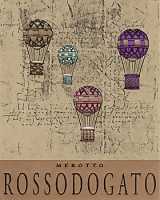
|
|
Rosso Dogato 2001 |
|
| Merotto (Veneto, Italy) | |
| Grapes: Cabernet Sauvignon | |
| Price: € 16.00 | Score: |
| Rosso Dogato shows an intense ruby red color and nuances of garnet red, little transparency. The nose reveals intense, clean, pleasing, refined and elegant aromas which start with hints of black cherry, black currant and plum followed by aromas of dried violet, vanilla, blueberry, leather, chocolate, tobacco, licorice, pink pepper, mace and eucalyptus. The mouth has good correspondence to the nose, a tannic attack and pleasing roundness, however balanced by alcohol, good body, intense flavors, agreeable. The finish is persistent with flavors of black currant, black cherry and plum. Rosso Dogato ages for 20 months in cask, 10 months in barrique and for 30 months in bottle. | |
| Food Match: Roasted meat, Stewed and braised meat, Hard cheese | |
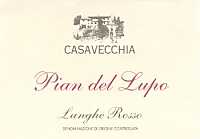
|
|
Langhe Rosso Pian del Lupo 2004 |
|
| Casavecchia Marco (Piedmont, Italy) | |
| Grapes: Nebbiolo (1/3), Merlot (1/3), Cabernet Sauvignon (1/3) | |
| Price: € 10.20 | Score: |
| Langhe Rosso Pian del Lupo shows a brilliant ruby red color and nuances of ruby red, moderate transparency. The nose denotes intense, clean, pleasing and refined aromas that start with hints of cherry, plum and violet followed by aromas of strawberry, raspberry, blueberry, vanilla, cinnamon, cocoa and menthol. The mouth has good correspondence to the nose, a tannic attack and however balanced by alcohol, good body, intense flavors, agreeable. The finish is persistent with flavors of cherry, plum and blueberry. Langhe Rosso Pian del Lupo ages for 12 months in barrique and for 12 months in bottle. | |
| Food Match: Roasted meat, Stewed and braised meat with mushrooms, Hard cheese | |
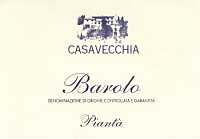
|
|
Barolo Piantà 2004 |
|
| Casavecchia Marco (Piedmont, Italy) | |
| Grapes: Nebbiolo | |
| Price: € 21.00 | Score: |
| Barolo Piantà shows a brilliant ruby red color and nuances of ruby red, moderate transparency. The nose reveals intense, clean, pleasing and refined aromas that start with hints of cherry, plum and raspberry followed by aromas of violet, rose, vanilla, tobacco, cocoa, cinnamon, anise and menthol. The mouth has good correspondence to the nose, a tannic attack and however balanced by alcohol, full body, intense flavors, pleasing crispness. The finish is persistent with flavors of cherry, plum and raspberry. Barolo Piantà ages for more than two years in cask followed by at least 18 months of aging in bottle. | |
| Food Match: Game, Roasted meat, Stewed and braised meat, Hard cheese | |
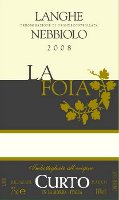
|
|
Langhe Nebbiolo 2007 |
|
| Curto Marco (Piedmont, Italy) | |
| Grapes: Nebbiolo | |
| Price: € 11.00 | Score: |
| Langhe Nebbiolo shows a brilliant ruby red color and nuances of garnet red, moderate transparency. The nose denotes intense, clean, pleasing and refined aromas that start with hints of cherry, plum and violet followed by aromas of raspberry, rose, vanilla, chocolate and menthol. The mouth has good correspondence to the nose, a tannic attack and however balanced by alcohol, good body, intense flavors, pleasing crispness. The finish is persistent with flavors of cherry, plum and raspberry. Langhe Nebbiolo ages for 2 years of which 6 months in cask. | |
| Food Match: Stuffed pasta, Broiled meat and barbecue, Stewed meat with mushrooms | |
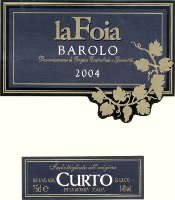
|
|
Barolo La Foia 2004 |
|
| Curto Marco (Piedmont, Italy) | |
| Grapes: Nebbiolo | |
| Price: € 27.00 | Score: |
| Barolo La Foia shows a brilliant ruby red color and nuances of garnet red, moderate transparency. The nose denotes intense, clean, pleasing and refined aromas which start with hints of cherry, plum and violet followed by aromas of raspberry, strawberry, rose, vanilla, cinnamon, pink pepper, chocolate and anise. The mouth has good correspondence to the nose, a tannic attack and however balanced by alcohol, full body, intense flavors, pleasing crispness. The finish is persistent with flavors of cherry, plum and raspberry. Barolo La Foia ages for two years in cask and for two years in bottle. | |
| Food Match: Roasted meat, Stewed and braised meat with mushrooms, Hard cheese | |
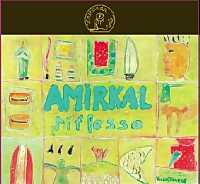
|
|
Amirkal Riflesso 2007 |
|
| Veneranda Vite (Marches, Italy) | |
| Grapes: Lacrima di Morro (90%), Cabernet Sauvignon (10%) | |
| Price: € 5.80 | Score: |
| Amirkal Riflesso shows an intense ruby red color and nuances of ruby red, little transparency. The nose reveals intense, clean, pleasing and refined aromas that start with hints of cherry, blackberry and plum followed by aromas of violet, raspberry, blueberry, cyclamen and hints of vanilla. The mouth has good correspondence to the nose, a tannic attack and however balanced by alcohol, good body, intense flavors, pleasing roundness. The finish is persistent with flavors of cherry, plum and blackberry. Amirkal Riflesso ages for 12 months in part in steel tanks and in part in barrique followed by 6 months of aging in bottle. | |
| Food Match: Roasted meat, Broiled meat and barbecue, Hard cheese | |
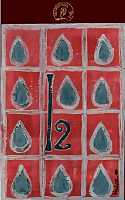
|
|
I2 2007 |
|
| Veneranda Vite (Marches, Italy) | |
| Grapes: Montepulciano | |
| Price: € 8.00 | Score: |
| I2 shows a deep ruby red color and nuances of ruby red, little transparency. The nose reveals intense, clean, pleasing and refined aromas which start with hints of plum, blackberry and black cherry followed by aromas of violet, blueberry, vanilla, tobacco, carob, mace and menthol. The mouth has good correspondence to the nose, a tannic attack and however balanced by alcohol, full body, intense flavors, pleasing roundness. The finish is persistent with flavors of black cherry, blackberry and plum. I2 ages for 10 months in barrique followed by 4 months of aging in bottle. | |
| Food Match: Game, Roasted meat, Stewed and braised meat, Hard cheese | |
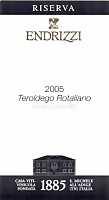
|
|
Teroldego Rotaliano Superiore Riserva Maso Camorz 2005 |
|
| Endrizzi (Trentino, Italy) | |
| Grapes: Teroldego | |
| Price: € 12.00 | Score: |
| Teroldego Rotaliano Superiore Riserva Maso Camorz shows a brilliant ruby red color and nuances of ruby red, little transparency. The nose denotes intense, clean, pleasing and refined aromas which start with hints of black cherry, plum and violet followed by aromas of blackberry, blueberry, vanilla, tobacco, chocolate and eucalyptus. The mouth has good correspondence to the nose, a tannic attack and however balanced by alcohol, good body, intense flavors, pleasing roundness. The finish is persistent with flavors of black cherry, plum and blueberry. Teroldego Rotaliano Superiore Riserva Maso Camorz ages in barrique and in cask. | |
| Food Match: Roasted meat, Stewed and braised meat, Hard cheese | |
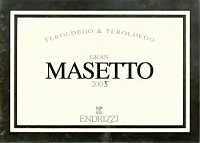
|
|
Gran Masetto 2005 |
|
| Endrizzi (Trentino, Italy) | |
| Grapes: Teroldego | |
| Price: € 32.00 | Score: |
| Gran Masetto shows a deep ruby red color and nuances of ruby red, little transparency. The nose reveals intense, clean, pleasing, refined and elegant aromas which start with hints of black cherry, blackberry and plum followed by aromas of blueberry, violet, cherry macerated in alcohol, vanilla, tobacco, mace, chocolate, cinnamon, nail polish and menthol. The mouth has good correspondence to the nose, a tannic and round attack, however balanced by alcohol, full body, intense flavors, pleasing hist of sweetness. The finish is very persistent with long flavors of blackberry, plum and black cherry. Half of Gran Masetto is made with dried Teroldego grapes and ages for 20 months in barrique followed by 6 months of aging in bottle. | |
| Food Match: Game, Roasted meat, Braised meat, Hard cheese | |
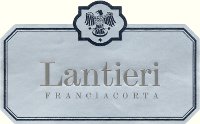
|
|
Franciacorta Satèn |
|
| Lantieri de Paratico (Lombardy, Italy) | |
| Grapes: Chardonnay | |
| Price: € 19.50 | Score: |
| This Franciacorta Satèn shows a pale straw yellow color and nuances of greenish yellow, very transparent, fine and persistent perlage. The nose reveals intense, clean, pleasing and refined aromas which start with hints of banana, yeast and apple followed by aromas of hazelnut, bread crust, hawthorn, citrus fruits, pear, peach, plum and vanilla. The mouth has good correspondence to the nose, a crisp and effervescent attack, however balanced by alcohol, good body, intense flavors, agreeable. The finish is persistent with flavors of apple, banana and plum. The base wine is aged for 3 months in barrique. This Franciacorta Satèn referments in bottle for 30 months. | |
| Food Match: Aperitifs, Fish and crustacean appetizers, Sauteed crustaceans | |
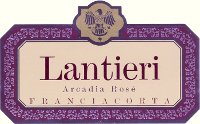
|
|
Franciacorta Brut Rosé Arcadia |
|
| Lantieri de Paratico (Lombardy, Italy) | |
| Grapes: Pinot Noir (60%), Chardonnay (40%) | |
| Price: € 24.00 | Score: |
| Franciacorta Brut Rosé Arcadia shows a pale onion skin pink color and nuances of pale pink, very transparent, fine and persistent perlage. The nose denotes intense, clean, pleasing and refined aromas which start with hints of banana, yeast and raspberry followed by aromas of cherry, strawberry, butter, tangerine, peach, cyclamen and apple. The mouth has good correspondence to the nose, a crisp and effervescent attack, however balanced by alcohol, good body, intense flavors, agreeable. The finish is persistent with flavors of cherry, banana and apple. Franciacorta Brut Rosé Arcadia referments for at least 30 months in bottle. | |
| Food Match: Cold cuts, Dairy products, Pasta and risotto with fish and crustaceans, Sauteed meat | |
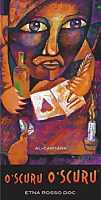
|
|
Etna Rosso O' Scuru O' Scuru 2006 |
|
| Al-Cantara (Sicily, Italy) | |
| Grapes: Nerello Mascalese, Nerello Cappuccio | |
| Price: € 21.60 | Score: |
| Etna Rosso O' Scuru O' Scuru shows a brilliant ruby red color and nuances of garnet red, moderate transparency. The nose denotes intense, clean, pleasing and refined aromas that start with hints of plum, black cherry and dried violet followed by aromas of blueberry, vanilla, cinnamon, mace and menthol. The mouth has good correspondence to the nose, a slightly tannic attack and however balanced by alcohol, good body, intense flavors. The finish is persistent with flavors of black cherry, plum and blueberry. Etna Rosso O' Scuru O' Scuru ages for 6 months in barrique followed by at least 12 months of aging in steel tanks. | |
| Food Match: Pasta with mushrooms, Stewed meat with mushrooms, Mushroom soups | |
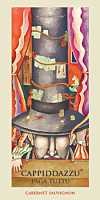
|
|
Cappiddazzu Paga Tuttu 2006 |
|
| Al-Cantara (Sicily, Italy) | |
| Grapes: Cabernet Sauvignon | |
| Price: € 19.20 | Score: |
| Cappiddazzu Paga Tuttu shows an intense ruby red color and nuances of ruby red, little transparency. The nose reveals intense, clean, pleasing and refined aromas which start with hints of plum, black cherry and black currant followed by aromas of blueberry, violet, vanilla, mace, cocoa and eucalyptus. The mouth has good correspondence to the nose, a tannic attack and however balanced by alcohol, good body, intense flavors, pleasing roundness. The finish is persistent with flavors of black cherry, black currant and plum. Cappiddazzu Paga Tuttu ages for 12 months in barrique and for 12 months in steel tanks. | |
| Food Match: Roasted meat, Stewed and braised meat, Hard cheese | |
News |
|
In this section are published news and information about events concerning the world of wine and food. Whoever is interested in publishing this kind of information can send us a mail to our address.
|
AquavitaeReview of Grappa, Distillates and Brandy |
|
|
| Distillates are rated according to DiWineTaste's evaluation method. Please see score legend in the "Wines of the Month" section. |
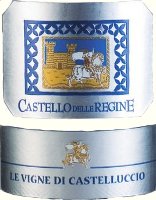
|
|
Grappa Le Vigne di Castelluccio |
|
| Castello delle Regine (Umbria, Italy) | |
| (Distiller: Distilleria Nannoni) | |
| Raw matter: Pomace of Merlot | |
| Price: € 21.00 - 70cl | Score: |
| This grappa is limpid, crystalline and colorless. The nose denotes intense, clean, pleasing and refined aromas of black cherry, plum, violet, hazelnut and licorice, with almost imperceptible alcohol pungency. In the mouth has intense flavors with perceptible alcohol pungency which tends to dissolve rapidly, good correspondence to the nose, balanced sweetness, pleasing smoothness. The finish is persistent with flavors of black cherry and plum. Alcohol 42%. | |
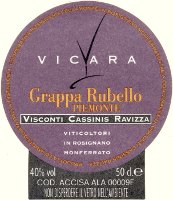
|
|
Grappa Rubello |
|
| Vicara (Piedmont, Italy) | |
| (Distiller: Distilleria Rosignano Cellamonte) | |
| Raw matter: Pomace of Barbera, Cabernet Sauvignon, Nebbiolo | |
| Price: € 15.84 - 50cl | Score: |
| This grappa is limpid, crystalline and colorless. The nose denotes intense, clean, pleasing and refined aromas of plum, violet, hazelnut, black cherry and raspberry, with almost imperceptible alcohol pungency. In the mouth has intense flavors with perceptible alcohol pungency which tends to dissolve rapidly, good correspondence to the nose, balanced sweetness, pleasing roundness. The finish is persistent with flavors of plum and black cherry. This grappa is distilled with a bainmarie alembic still. Alcohol 40%. | |
Wine Parade |
|
|
| The best 15 wines according to DiWineTaste's readers. To express your best three wines send us an E-mail or fill in the form available at our WEB site. |
| Rank | Wine, Producer | |
|---|---|---|
| 1 |
| Aglianico del Vulture La Firma 2004, Cantine del Notaio (Italy) |
| 2 |
| Villa Gresti 2004, Tenuta San Leonardo (Italy) |
| 3 |
| Arkezia Muffo di San Sisto 2004, Fazi Battaglia (Italy) |
| 4 |
| Sangiovese di Romagna Superiore Riserva Thea 2005, Tre Monti (Italy) |
| 5 |
| Merlot 2004, Castello delle Regine (Italy) |
| 6 |
| Moscato d'Asti 2007, Vignaioli di S. Stefano (Italy) |
| 7 |
| Barolo Bussia 2001, Prunotto (Italy) |
| 8 |
| San Leonardo 2001, Tenuta San Leonardo (Italy) |
| 9 |
| Collio Bianco Col Disôre 2004, Russiz Superiore (Italy) |
| 10 |
| Sforzato di Valtellina San Domenico 2002, Triacca (Italy) |
| 11 |
| Barolo Sorano 2004, Alario (Italy) |
| 12 |
| Sagrantino di Montefalco Passito 2004, Adanti (Italy) |
| 13 |
| Amarone della Valpolicella Classico Vigneto Monte Sant'Urbano 2004, Speri (Italy) |
| 14 |
| Sagrantino di Montefalco Collepiano 2003, Arnaldo Caprai (Italy) |
| 15 |
| Blanc des Rosis 2006, Schiopetto (Italy) |
| |||||||
Privacy Policy | |||||||


| Copyright © 2002-2024 Antonello Biancalana, DiWineTaste - All rights reserved |
| All rights reserved under international copyright conventions. No part of this publication and of this WEB site may be
reproduced or utilized in any form or by any means, electronic or mechanical, without permission in writing from DiWineTaste. |